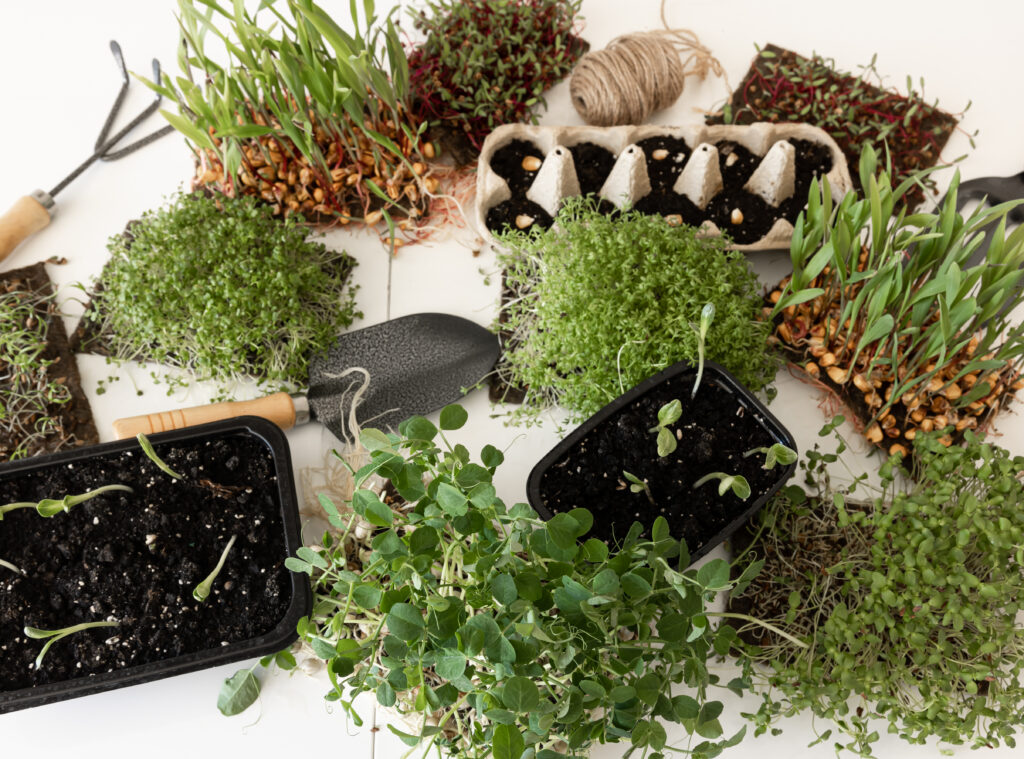What Are Microgreens and Why Are They So Popular?
Discover the Nutritional Power of These Tiny Greens
Microgreens are the embryonic versions of leafy greens and herbs harvested just after their cotyledon leaves have developed. Don’t let their small size fool you. These verdant sprigs are nutritional powerhouses and often contain up to 40 times more vitamins and antioxidants than their mature counterparts. A mere handful can infuse your plate with chlorophyll, phytonutrients, and flavour.
How They Differ from Sprouts and Baby Greens
While sprouts are germinated seeds grown entirely in water and consumed whole, roots and all, microgreens are grown in soil or a growing medium and harvested above the root line. Microgreens are older and more significant than sprouts, typically taking weeks. They strike a perfect balance between size and nutrition, reaching harvest readiness in 7 to 10 days, making them ideal for quick harvests and instant gratification.
Why They’re a Favourite Among Chefs, Nutritionists, and Home Gardeners
Their vivid colours, layered textures, and punchy flavours make microgreens a darling of gourmet kitchens. Nutritionists love them for their density of nutrients in a small serving. And home gardeners? They adore how fast and fuss-free they are, ideal for windowsills and small apartments with zero outdoor space.
The Incredible Health Benefits
Packed with Vitamins, Minerals, and Antioxidants
Discover the impressive benefits of microgreens, from cauliflower varieties rich in sulforaphane to radishes packed with vitamin C. Each type of microgreen boasts a distinct nutritional profile, offering a wealth of vitamin K, beta-carotene, iron, magnesium, and polyphenols. These powerful nutrients support bone health and promote cellular repair, making microgreens a smart addition to any healthy diet!
How They Support Immunity, Digestion, and Energy Levels
Regular consumption of microgreens can strengthen the immune system thanks to their immune-boosting compounds. High in enzymes and dietary fibre (when consumed fresh), they gently assist digestion while supplying sustained energy, thanks to the bioavailability of their nutrients. It’s like nature’s multivitamin, alive, fresh, and bursting with vitality.
Scientific Backing: What Studies Say About Microgreens
Research has shown that specific microgreens, including red cabbage and cilantro, provide significantly higher levels of vitamins C and E, along with lutein, compared to their fully grown versions. This compelling evidence highlights their potential benefits, including cancer prevention, inflammation reduction, and effective management of chronic diseases. Embracing these nutrient-rich microgreens could be a thoughtful addition to your diet for better health.
Best Microgreens to Grow
Mild & Nutritious
- Fenugreek (Methi) – Great for digestion and immunity.
- Wheatgrass – Ideal for juicing, detoxifying.
- Sunflower – Crunchy, rich in protein and healthy fats.
- Pea Shoots – Sweet and crunchy, high in vitamin C.
- Lettuce – Mild flavour, great for salads.
- Spinach – Rich in iron and vitamins.
Spicy & Zesty
- Mustard Greens (Sarson) – Spicy, packed with antioxidants.
- Radish – Peppery taste, boosts metabolism.
- Arugula (Rocket Leaves) – Strong, tangy flavour, aids digestion.
- Onion Greens – Mild onion flavour, rich in sulfur.
- Garlic Chives – Adds a garlicky kick, anti-inflammatory.
Herbal & Aromatic
- Coriander (Dhaniya) – Adds fresh flavour to dishes.
- Basil – Mildly sweet, enhances immunity.
- Dill – Fresh taste, aids digestion.
- Parsley – Refreshing, packed with vitamin C.
- Fennel – Subtle liquorice flavour, good for digestion.
Colorful & Unique
- Amaranth (Rajgira) – Rich in iron and protein.
- Beet Greens – Adds colour and earthy flavour, high in folate.
- Carrot Greens – Mildly bitter, full of antioxidants.
- Red Cabbage – Beautiful purple colour, high in vitamin K.
- Purple Kohlrabi – Crunchy, loaded with vitamins.
Superfoods & Speciality Greens
- Chia – Omega-3-rich, great for energy.
- Kale – Nutrient powerhouse, great for smoothies.
- Alfalfa – Has a mild flavour and is rich in enzymes.
- Moringa – Packed with antioxidants and essential amino acids.
The Minimalist’s Microgreens Kit: What You Need
Essential Supplies You Probably Already Have at Home
A shallow container, a lid or tray, potting mix or coconut coir, a spray bottle, and seeds are all you need. Even repurposed takeout containers or baking trays can become your growing station. No fancy equipment is required.
Soil vs. Hydroponics: Which is Better for You?
Soil offers a richer flavour and is more forgiving for first-timers. Hydroponics, using mediums like hemp mats or coco coir, provide a cleaner harvest and less mess. Both methods yield healthy microgreens chosen based on your lifestyle and maintenance preference.
Best Containers for Small Spaces and Big Yields
Opt for wide, shallow trays that promote even seed distribution. Drainage holes help prevent mold. For the space-savvy, stackable trays or vertical growing kits maximise yield in tight spaces like kitchen counters or balconies.
Step-by-Step Guide: Growing Microgreens in Just 7 Days
Day 1–2: Soaking and Seeding Like a Pro
Soak larger seeds like sunflower and peas overnight. For smaller seeds, dry-sow them generously over moistened soil. Press lightly to ensure seed-to-soil contact. Cover with a dark lid or damp cloth to simulate soil darkness and encourage germination.
Days 3–4: Sprouting and Providing the Right Environment
As roots emerge, remove the lid and introduce indirect sunlight. Keep the medium moist using a spray bottle; never let it dry out. Maintain temperatures between 18–24°C for optimal growth.
Days 5–7: Light, Water, and Watching Them Flourish
Microgreens respond well to natural sunlight or a basic grow light. Water from the base, if possible, to avoid mold on leaves. By day 7, they’ll have unfurled their first true leaves and be ready for harvest.
Troubleshooting Common Microgreen Mistakes
Why Aren’t My Seeds Sprouting?
Check seed quality and expiration dates. Too much water or insufficient warmth can also hinder germination. Avoid compacting the soil aeration is key.
Avoiding Mould, Overwatering, and Other Rookie Errors
Poor ventilation and excessive surface moisture are mold’s best friends. Water sparingly and ensure your trays have drainage. A small fan or open window can work wonders.
How to Tell When They’re Ready to Harvest (And When It’s Too Late)
Harvest when the first set of true leaves appears, usually around day 7–10. Wait too long and the flavour becomes bitter, the stems tougher, and the nutrient density lower.
Harvest Time: When and How to Cut Your Microgreens Just Right
Tools You’ll Need for a Clean Harvest
Use sanitised scissors or a sharp knife. Harvest in the morning for maximum crispness. Hold stems gently and snip just above the soil line to avoid grit.
How to Maximise Flavour and Nutrient Density
Harvest only what you need. Microgreens are at their peak just before the second leaf set. Immediate consumption ensures optimal taste and nutrition.
Post-Harvest Storage Tips to Keep Them Fresh
Store dry microgreens in airtight containers with a paper towel to absorb moisture. Keep refrigerated and consume within 3–5 days. Never wash until right before use.
Creative Ways to Eat and Enjoy Your Microgreens
Delicious Ideas: Salads, Smoothies, Sandwiches & More
Sprinkle over avocado toast, toss into fresh pasta, blend into green smoothies, or top off a bowl of soup for that fresh, living crunch. They elevate any dish visually and nutritionally.
Boosting Everyday Meals with a Microgreen Twist
Add a microgreen layer to burgers, tacos, or stir-fries. Fold into omelettes or garnish risottos and grain bowls. They’re an easy, impressive upgrade for home-cooked meals.
Kid-Friendly Recipes to Get the Whole Family Involved
Turn microgreens into mini pizzas, colourful wraps, or even DIY sushi rolls. Let kids grow their tray, it’s a great way to spark curiosity and build healthy habits.
Scaling Up: Turning a Hobby into a Hustle
Selling Microgreens at Farmers’ Markets or to Local Cafés
Microgreens are in high demand at farmers’ markets and local bistros. Create sampler boxes or custom blends for specific clientele. Local chefs often seek premium, fresh greens with unique flavours.
Cost Breakdown and Profit Potential for Small-Batch Growers
With low startup costs and fast turnaround, microgreens offer an excellent profit margin. A single tray can yield multiple servings and fetch a premium if organically grown and well-presented.
Branding and Packaging Tips for Stand-Out Microgreens
Use eco-friendly packaging, craft a clean, minimal brand aesthetic, and tell your story, people love knowing where their food comes from. Add care instructions or recipes to build customer loyalty.
Eco-Friendly and Sustainable Microgreens Growing Tips
Reduce Waste with Composting and Reuse
Compost used soil and spent roots. Reuse trays and tools. Choose biodegradable packaging and keep your carbon footprint small.
Choosing Organic and Heirloom Seeds for Healthier Crops
Organic and heirloom seeds not only yield tastier greens but also promote biodiversity and soil health. Avoid GMO seeds and opt for trusted seed suppliers.
How Microgreens Support a Greener, Healthier Planet
Growing microgreens at home reduces food miles, packaging waste, and reliance on mass-produced produce. It’s a step toward self-sufficiency and conscious living, one tray at a time.
Final Thoughts
Growing microgreens at home is a simple, rewarding way to add fresh, nutritious greens to your diet. Whether you want to boost your salads, smoothies, or everyday meals, these tiny plants pack a powerful punch of flavour and health benefits.
Ready to start growing? Stay tuned for our recommended microgreen kits and organic soil blends from Organic Kokan!
Would you like us to add specific product mentions now, or keep it flexible for future updates?


